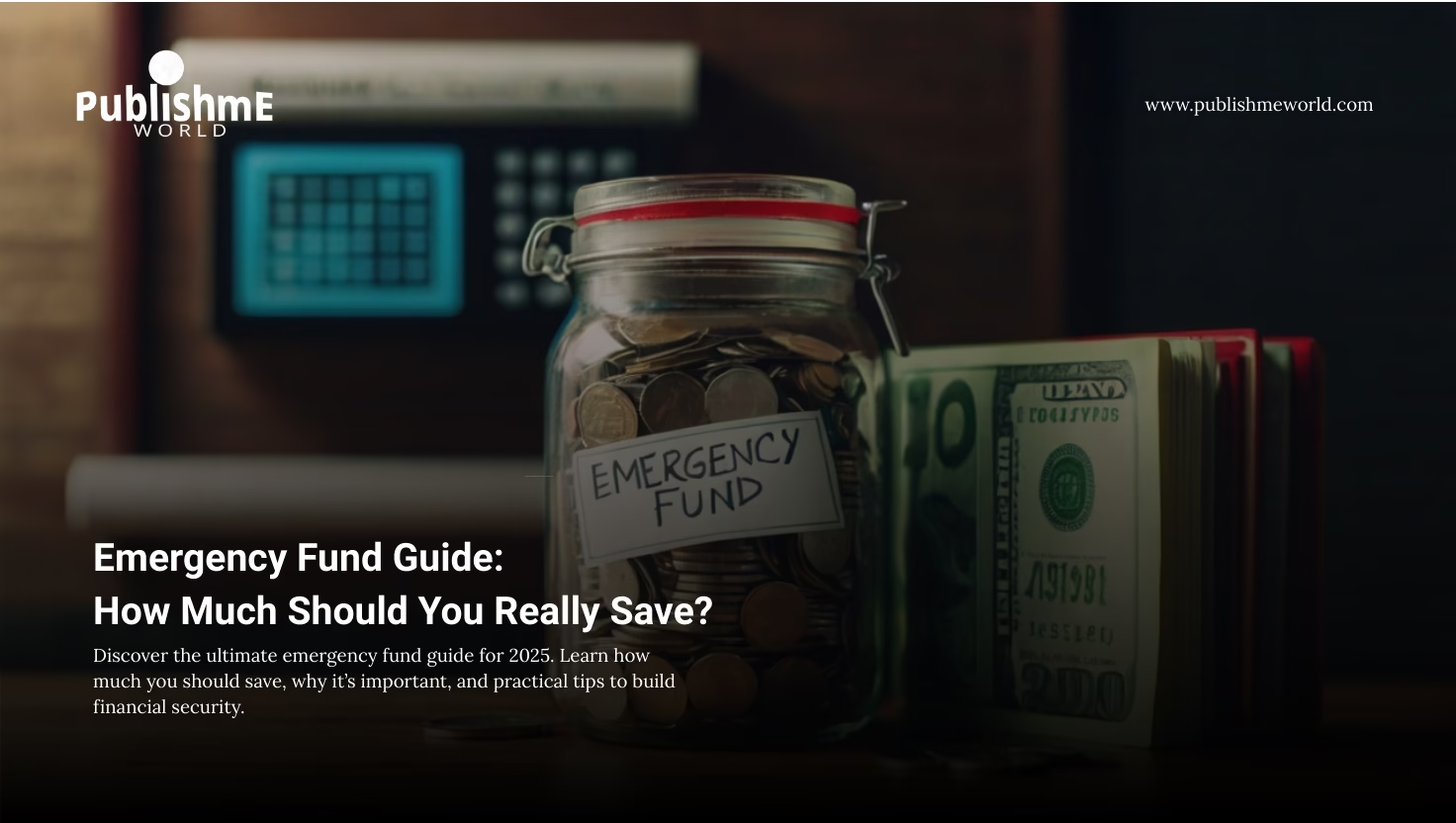Contents
- 1 Introduction
- 2 Why an Emergency Fund Matters
- 3 How Much Should You Save?
- 4 Steps to Build Your Emergency Fund
- 5 Step 4: Choose the Right Account
- 6 Tips to Accelerate Your Savings
- 7 Common Mistakes to Avoid
- 8 Emergency Fund vs. Other Savings
- 9 Tips to Accelerate Your Savings
- 10 How to Use Your Emergency Fund Wisely
- 11 Final Thoughts
Introduction
Emergency Fund Guide Life is unpredictable. From a sudden medical bill to loss of work or unexpected car repair, financial emergency can strike at any time. This is why an emergency fund is one of the most essential parts of a solid financial plan. It provides protection, reduces stress and helps you avoid debt when you are unpredictable expenses. But the big question is: How much should you really save in your emergency fund?
In this guide we will find out the importance of an emergency fund, factors that determine how much you need, and to make smart strategies one.
Why an Emergency Fund Matters
Emergency Fund Guide An emergency fund acts as your financial security trap. Without one, many people approach credit cards or individual loans at the time of crisis, which only causes more financial stress. Why is an emergency fund important here:
- Financial security— Emergency Fund Guide ensures that you can cover unexpected expenses without relying on debt.
- Mind in the mind – knowing that you have a pillow, reduces the concern for the future.
- Flexibility – This gives you the freedom to make better decisions during the crisis without financial pressure.
Debt protection-hopes you from putting in loans with high claims during an emergency.
How Much Should You Save?
Emergency Fund Guide The amount you need in your emergency fund depends on your lifestyle, income stability and financial responsibilities. Economic experts usually recommend:
1. 3 to 6 months rule
Save the expenses to stay for 3 to 6 months in your emergency fund.
It will meet the requirements such as rent/mortgage loans, food, tools, insurance and transport.
Emergency Fund Guide For example, if your monthly expenses are 50,000, you should target against protecting against 1.5 lakh to £ 3 lakh.
2. Simple vs dual -income house
Those who earn individual income should target at least 6 months of expenses such as work reduction can be risky.
Double income can manage by 3 months since they are a backup source.
3. Job stability
Emergency Fund Guide If you work in a stable government job, 3 months may be sufficient.
Emergency Fund Guide If you are in a freelancer, entrepreneur or unstable industry, consider saving 9-12 months expenses.
4. Family responsibility
Emergency Fund Guide Families with children, parents or medical requirements should increase the emergency funds.
Steps to Build Your Emergency Fund
Step 1: Calculate Your Monthly Expenses
Track your fixed and variable costs including rent, groceries, bills, insurance, and transportation. This gives you a clear savings target.
Step 2: Set a Savings Goal
Based on your expenses, set a clear goal like “Save ₹2.5 lakh in 18 months.”
Step 3: Start Small but Stay Consistent
Emergency Fund Guide Even saving ₹5000 per month adds up over time. Automate transfers into a separate savings account.
Step 4: Choose the Right Account
Keep your emergency fund in a liquid savings account, money market account, or short-term fixed deposit. It should be accessible but not so easy that you spend it unnecessarily.
Step 5: Increase Contributions Gradually
Whenever you get a raise, bonus, or extra income, direct a portion toward your emergency fund.
Tips to Accelerate Your Savings
- Cut unnecessary expenses—review membership, food, and luxury expenses.
- Take a side turn—freelance, teaching, or online sales can generate extra income.
- Automatically your savings plans auto-debit to avoid death.
- Use windfalls with care—direct tax reimbursement, bonuses, or gifts in your emergency fund.
Common Mistakes to Avoid
- Using it in non-fruit periods-a emergency fund is not for holidays or shopping. This is strictly for unexpected needs.
- Do not refill after use – if you use it, you can start reconstruction immediately.
- Keeping too much money – even if security is important, don’t keep all your money cash. After a point, invest extra savings in mutual funds, equity or pension accounts.
- Ignoring inflation – your fund will grow with inflation. Relax your goal every year.
Emergency Fund vs. Other Savings
It’s important to distinguish between your emergency fund and other savings goals:
- Emergency Fund – For unexpected life events like job loss or health issues.
- Short-Term Savings – For planned expenses like vacations or buying a gadget.
- Investments – For long-term wealth building such as retirement or property.
By keeping them separate, you ensure your safety net remains intact.
Tips to Accelerate Your Savings
- Cut Unnecessary Expenses – Review subscriptions, dining out, and luxury spending.
- Take Up a Side Hustle – Freelancing, tutoring, or selling online can add extra income.
- Automate Your Savings – Schedule auto-debits to avoid temptation.
- Use Windfalls Wisely – Direct tax refunds, bonuses, or gifts to your emergency fund.
How to Use Your Emergency Fund Wisely
When the time comes to use your fund, follow these rules:
- Evaluate the Situation – Ask: Is this a real emergency or just an inconvenience?
- Withdraw Only What’s Necessary – Take just enough to cover the expense.
- Rebuild Promptly – Restart your contributions immediately after withdrawal.
Final Thoughts
An emergency fund is your first line of defense in personal finance. While the exact amount you need depends on your situation, a good rule of thumb is to save 3 to 6 months of expenses.
Start small, stay consistent, and protect your financial stability. Remember, it’s not about how fast you save but about building a reliable cushion that keeps you secure no matter what life throws your way.
Your emergency fund isn’t just savings—it’s peace of mind.





